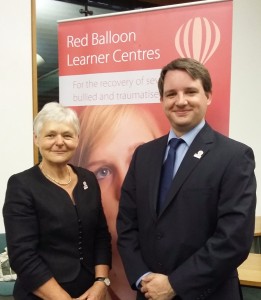 The Good Childhood Report by The Children’s Society made for stark reading.
The Good Childhood Report by The Children’s Society made for stark reading.
It found that children in England experienced the highest levels of emotional bullying out of the 15 countries surveyed. Half the children reported being left out by their classmates and 38 per cent said they had been hit by other children in the last month. Bullied children were more likely to have low self esteem than other children.
Those that had been bullied four or more times in the last three months were six times more likely to have low self esteem than those that had not. The myth that ‘bullying makes you stronger’ is just that.
Increasingly anti-bullying organisations are combining their efforts to ensure the best framework is in place in schools. This includes the All Party Parliamentary Inquiry into school bullying, which successfully ensured amendments in the Children and Family Bill to give greater recognition to bullying in schools. Debates have also taken place in both houses. Pictured right with Dame Esther Rantzen DBE.
framework is in place in schools. This includes the All Party Parliamentary Inquiry into school bullying, which successfully ensured amendments in the Children and Family Bill to give greater recognition to bullying in schools. Debates have also taken place in both houses. Pictured right with Dame Esther Rantzen DBE.
But there is a long way to go to secure the change that is required, and the scale of the problem demonstrated in the Good Childhood report.
The effects of bullying leave deep emotional scars often into adulthood. King’s College Institute of Psychiatry commissioned a substantial study of over 7,700 people, who were born in 1958, who were bullied at 7 or 11 years old. The study then followed up with the participants until they were 50 years old.
The study found that the impact of bullying is still visible up to mid-life, four decades after people were bullied. Symptoms included depression, anxiety and a greater likelihood to have suicidal thoughts than those who had not been bullied.
The study also found a direct link between childhood bullying and poor outcomes in mid-life with health, social and economic consequences. This included lower educational levels, more likely to be unemployed, lower earnings. Those bullied were less likely to be in a relationship or to have good social network.
In this country there is a serious injustice that is taken place now, in 2015. Currently a child excluded for aggressive and persistent bullying may be transferred to alternative provision such as a pupil referral unit at a cost of between £16 and 23K per year.
However, if a child subjected to bullying behaviour – the victim – becomes school phobic there is little or no alternative provision available or offered. They leave school and receive little or no support becoming more and more depressed with a bleak academic future. How can this be right?
For a moment just imagine 750 secondary school classrooms empty week in, week out, all year round. Could you imagine the outcry, the headlines? Let me explain; there are over 16,000 between the ages of 11 and 15 missing education in England because of severe bullying (NatCen Report 2011).
This varies from name calling to physical attacks to cyber bullying and many more besides. And the figure of 16,000 is likely to be an underestimate, as many local authorities do not record the reason for a parent withdrawing their child from school.
So 16,000 children translates into 750 classrooms. Can you imagine the lost potential? But because the numbers are spread across all schools no one notices.
These silent victims need people to stand up for them. Many organisations and people are; and I am adding my name to the call for action.
To be clear, as the Kings College study demonstrates that this is not a new situation. I have spoken to people across the spectrum of ages and backgrounds. Everyone I speak to knows someone who was bullied or was themselves.
Indeed the charity Red Balloon, which provides alternative educational provision for children that are school phobic due to bullying, has been operating for nearly 20 years.
You may ask how can it be possible for so many children to leave education?
Well it usually happens as a last resort. When the situation deteriorates (with the child no longer attending school due to becoming school phobic, and parents who may be threatened with being taken to court for allowing their child to truant) the worn down parents agree for their child to be managed off the school role and outside the formal education framework.
Schools can meet the educational inspection criteria for the support of self-excluding students who have been bullied by having work sent home, having a teacher assistant available or by enabling the student to access the curriculum online.
In some cases such measures work satisfactorily, but is satisfactory as a best outcome good enough?
The approach required must be twofold. First, to put in place the measures needed to actively reduce bullying in schools. When the Good Childhood report estimates that half of children experience some form of bullying and over a third on the receiving end of physical bullying in the last month, we owe it to the next generation to do something.
Second is to ensure that in the worst case scenario where a child self excludes that there is a safety net for children who can no longer attend mainstream education, with the aim of returning them to mainstream education once fully recovered.
 Wishful thinking? The charity Red Balloon Learner Centre Group have a record of 95 per cent of severely bullied children who stay with them longer than six weeks returning to mainstream education and leading productive lives. Indeed this year RB-Norwich was deemed ‘Outstanding’ by Ofsted. Pictured with Dr Carrie Herbert MBE, President of the charity.
Wishful thinking? The charity Red Balloon Learner Centre Group have a record of 95 per cent of severely bullied children who stay with them longer than six weeks returning to mainstream education and leading productive lives. Indeed this year RB-Norwich was deemed ‘Outstanding’ by Ofsted. Pictured with Dr Carrie Herbert MBE, President of the charity.
The parallel that I would draw is MRSA. Hospitals have made real strides in reducing infection rates, but in the worst case scenario ensure that the patient receives the treatment required. Why cannot the same principle be applied to bullied children?
The six-point approach that is needed;
- Training for school staff and whole school programmes to tackle bullying.
- Special educational needs status should be granted to severely bullied children too traumatised to attend school.
- The educational needs of self-excluding bullied children must be met.
- Alternative provision must be monitored.
- Each LA and school must make it clear to parents/carers how the education of children self-excluding from school due to bullying is to be funded.
- The DfE needs to state its policy on distance learning.
A more detailed exposition of the above six aims is detailed in my previous article.
In developing this article I am grateful to a number of organisations and people in the sector – especially to Red Balloon Learner Centre Group.
With anti-bullying week approaching next month the need for action is now.